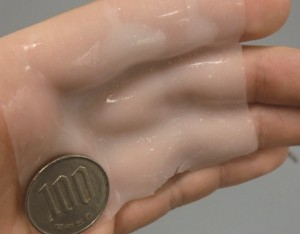Biometric information sensor that directly adheres to the body like a plaster With adhesive gel, sensor stays in contact even in motion

Professor Takao Someya, postdoctoral researcher Sung Won Lee and their research group at the Graduate School of Engineering, the University of Tokyo, have developed an adhesive gel and succeeded in manufacturing a sheet sensor that can measure biometric information just by application to the body like a sticking plaster.

© 2015 Takao Someya.
Adhesive gel with superior biocompatibility that can be formed into patterns with light. This novel type of gel can fit to the shape of the fingers when applied to the hand. The gel surface has strong adhesion, and a 100 yen coin does not fall off even when shaken.
The technological importance of measuring biometric information is increasing in line with remarkable developments in information technology such as big data. To improve the accuracy of measurements, it is ideal to put the sensor in direct contact with what is to be measured. As such, in order to reduce discomfort when sensors are directly applied to the body, researchers are seeking to fabricate electronic components on flexible substances such as polymeric film. However, there have been demands to realize a high degree of functionality on the interface that come into direct contact, such as adhesiveness and conforming to the shape of the body surface.
Using limited materials with superior biocompatibility, the research group succeeded in making adhesive gel capable of being formed into various patterns with light. Furthermore, they used the gel to realize sheet sensors that can perform biometric measurement just by application to the body like a sticking plaster. These sheet sensors can detect bioelectric signals, such as physical movement or electrical activity of the heart, by directly applying to human skin or the surface of the heart of a rat. The adhesive gel prevents the sheet sensor from slipping or falling off the surface during dynamic movement, and allows stable and long-term measurement.
Paper
Sungwon Lee, Yusuke Inoue, Dongmin Kim, Amir Reuveny, Kazunori Kuribara, Tomoyuki Yokota, Jonathan Reeder, Masaki Sekino, Tsuyoshi Sekitani, Yusuke Abe, & Takao Someya,
“A strain-absorbing design for tissue-machine interfaces using a tunable adhesive gel”,
Nature Communications Online Edition: 2014/12/19 (Japan time), doi: 10.1038/ncomms6738.
Article link(Publication)
Links
Graduate School of Engineering
Department of Electrical Engineering and Information Systems (EEIS), Graduate School of Engineering
Exploratory Research for Advanced Technology (ERATO), Japan Science and Technology Agency (JST)







